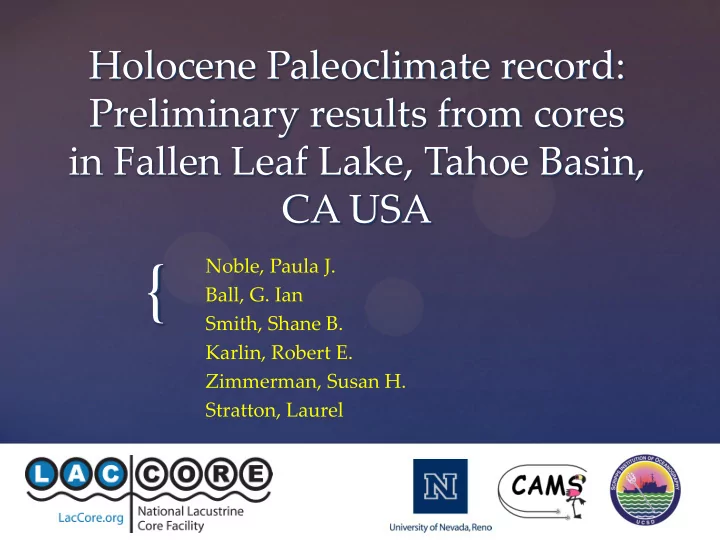

Holocene Paleoclimate record: Preliminary results from cores in Fallen Leaf Lake, Tahoe Basin, CA USA Noble, Paula J. { Ball, G. Ian Smith, Shane B. Karlin, Robert E. Zimmerman, Susan H. Stratton, Laurel
Fallen Leaf Lake- sensitive to past droughts Current lake level is 45m above Late Tahoe FLL drowned trees – 50-60m base level drop, multi- centennial duration (Kleppe 2005, Kleppe et al, 2011) How would drought induced base-level drops be manifested in lake sediment cores? Modified from Kleppe et al., (2011)
Map of core locations BOLLY project: 2010 Coring program LacCore ’ s Kullenberg coring platform
CHIRP Profile of FLL showing core positions Map of core locations 2006 CHIRP images courtesy of G. Kent, N. Driscoll, J. Maloney
Objectives Characterize and date the major stratigraphic packages observed in the lake cores Generate baseline organic geochemistry to evaluate sensitivity as climate proxy Using Develop sedimentary diatom record as a proxy for past climate, particularly drought history
Correlations using sedimentology and magnetic susceptibility MRE turbidite Post-Tsoyowata turbidite Tsoyowata ash Laminated interval Late Tioga glacial outwash
Age model 37 AMS 14 C ages generated at CAMS Top of core 2D constrained by 210 Pb Macrofossils (pine needles, leaves) Only 1 reversal
Organic Geochemistry CORE 2D Inferred climate from Pyramid Lake pollen (Mensing et al., 2004) TOC N (%) δ 13 C (‰) PDB δ 15 N (‰) AIR C:N Magnetic Susceptibility (x10 -6 SI) (%) 150 50 250 0 FLL lowstand 820-650 BP Medieval Climate Anomaly (Kleppe et al., 2011) 2700 Lower sed. rate 2 mid-Holocene dry 4000 Meters Below Lake Floor 4300 4600 period 4800 4 LT drowned tree ages 6500 - ~4800 BP (Lindstrom, 1990) 6300 6 Lower sed. rate 7600 Tsoyawata ash 7800 Dropstones - 8 ice cover? 9000 1 0 9800 Laminated Interval 10,400 BP
Organic Geochemistry CORE 1A - completed on base only End Tioga glaciation well constrained at 12.5 BP TOC (%) N (%) δ 13 C (‰) PDB δ 15 N (‰) AIR C:N Magnetic Susceptibility (x10 -6 SI) Tsoyawata ash 9.1 PB Laminated Interval 12.3 PB 12.6 PB Late Tioga glacial 13.3 PB outwash
Diatom analysis Taxonomic analysis 20 cm snapshot view of Holocene for long term trends and shifts High resolution sampling of selected intervals Across geochemical and sedimentological shifts Drought events (eg MCA) Spatial assessment between northern and southern sub-basins as a depth proxy
Late Tioga diatoms - mixed flora dominated by shallower water mesotrophic forms Phytoplankton: Cyclotella rossi group Discostella Stephanodicsus Aulacoseira pusilla 10 m m Periphyton : Small monoraphids (eg. Psammothidium, Karayevia, Planothidium ) Epithemia, Gomphonema Araphid periphyton Vivianite-bearing silty clay
Laminated interval diatoms – transitions into flora dominated by centric phytoplankton Aulacoseira subarctica - winter taxon, moderate P demands, windy, vigorous mixing Cyclotelloids P. bodanica – epilimnial species D. woltreckii D. stelligera Periphyton smaller component
Summary Late Pleistocene (base or core 1A): Late Tioga glaciation constrained at 12,500 BP with FLL age model Shift in % TOC and TON - clastic content Shift in d 13 C and d 15 N change in source material Diatoms – mesotrophic shallow water flora TOC (%) N (%) δ 13 C (‰) PDB δ 15 N (‰) AIR C:N 9.1 12.3 12.6 13.3
Summary (cont ’ d) Holocene (core 2D): Sedimentation rates reasonably high (1.9-1.4 mm/year): Lower during 6.3-7.6 BP 2.7-3.4 BP Geochemistry C:N ratios stable, steady supply of source material turbidites show strong terrestrial carbon signature Several inflections in d 13 C and d 15 N Diatoms – large % of variance in Aulacoseira subarctica A. subarctica dominated: wetter windy conditions – turbulence and mixing, intermittent ice cover
Acknowledgements Michael Rosen (USGS) for logistical support and advice, Graham Kent, Neil Driscoll, and Jillian Maloney (Scripps, NSL) for providing CHIRP data, Anders Noren and Christina Brady (LacCore) for helping us take these great cores, and our intrepid UNR coring/mobilization crew: Annie Kell, Amy Eisses, Jon Payne, and Josh Michaels.
Recommend
More recommend